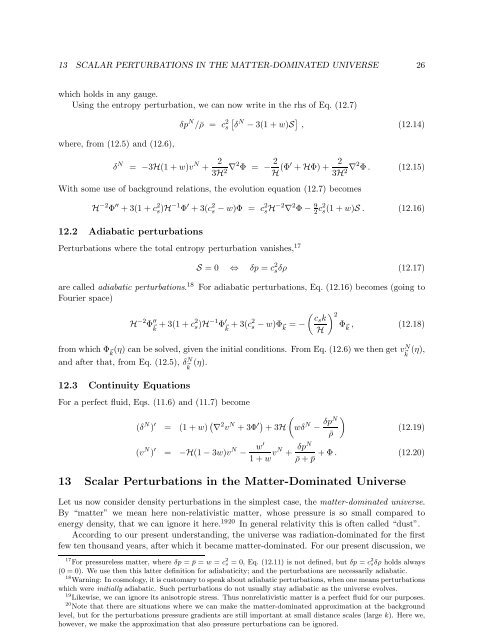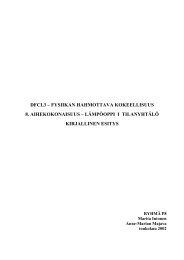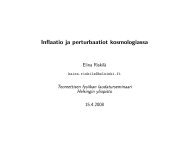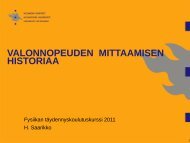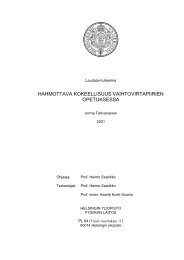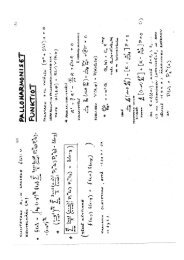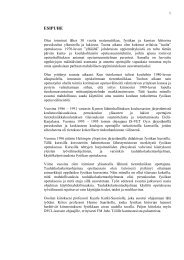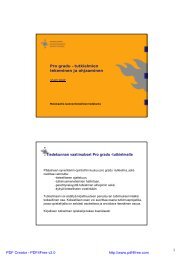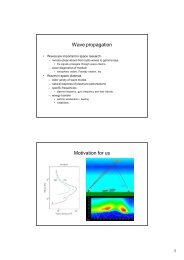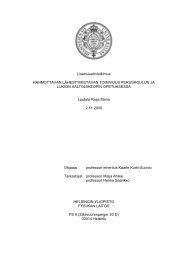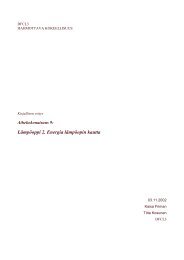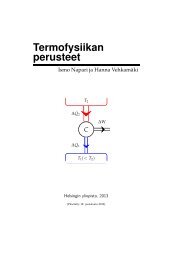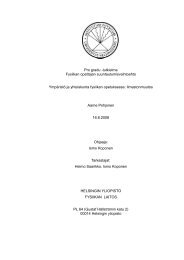Cosmological Perturbation Theory, 26.4.2011 version
Cosmological Perturbation Theory, 26.4.2011 version
Cosmological Perturbation Theory, 26.4.2011 version
Create successful ePaper yourself
Turn your PDF publications into a flip-book with our unique Google optimized e-Paper software.
13 SCALAR PERTURBATIONS IN THE MATTER-DOMINATED UNIVERSE 26which holds in any gauge.Using the entropy perturbation, we can now write in the rhs of Eq. (12.7)δp N /¯ρ = c 2 [s δ N − 3(1 + w)S ] , (12.14)where, from (12.5) and (12.6),δ N = −3H(1 + w)v N + 23H 2 ∇2 Φ = − 2 H (Φ′ + HΦ) + 23H 2 ∇2 Φ . (12.15)With some use of background relations, the evolution equation (12.7) becomesH −2 Φ ′′ + 3(1 + c 2 s )H−1 Φ ′ + 3(c 2 s − w)Φ = c2 s H−2 ∇ 2 Φ − 9 2 c2 s (1 + w)S . (12.16)12.2 Adiabatic perturbations<strong>Perturbation</strong>s where the total entropy perturbation vanishes, 17S = 0 ⇔ δp = c 2 sδρ (12.17)are called adiabatic perturbations. 18 For adiabatic perturbations, Eq. (12.16) becomes (going toFourier space)( )H −2 Φ ⃗ ′′k+ 3(1 + c 2 s)H −1 Φ ⃗ ′ k+ 3(c 2 cs k 2s − w)Φ ⃗k = − Φ ⃗k , (12.18)Hfrom which Φ ⃗k (η) can be solved, given the initial conditions. From Eq. (12.6) we then get v N ⃗ k(η),and after that, from Eq. (12.5), δ N ⃗ k(η).12.3 Continuity EquationsFor a perfect fluid, Eqs. (11.6) and (11.7) become(δ N ) ′ = (1 + w) ( )∇ 2 v N + 3Φ ′) + 3H(wδ N − δpN¯ρ(12.19)(v N ) ′ = −H(1 − 3w)v N − w′1 + w vN + δpN¯ρ + ¯p + Φ . (12.20)13 Scalar <strong>Perturbation</strong>s in the Matter-Dominated UniverseLet us now consider density perturbations in the simplest case, the matter-dominated universe.By “matter” we mean here non-relativistic matter, whose pressure is so small compared toenergy density, that we can ignore it here. 1920 In general relativity this is often called “dust”.According to our present understanding, the universe was radiation-dominated for the firstfew ten thousand years, after which it became matter-dominated. For our present discussion, we17 For pressureless matter, where δp = ¯p = w = c 2 s = 0, Eq. (12.11) is not defined, but δp = c 2 sδρ holds always(0 = 0). We use then this latter definition for adiabaticity; and the perturbations are necessarily adiabatic.18 Warning: In cosmology, it is customary to speak about adiabatic perturbations, when one means perturbationswhich were initially adiabatic. Such perturbations do not usually stay adiabatic as the universe evolves.19 Likewise, we can ignore its anisotropic stress. Thus nonrelativistic matter is a perfect fluid for our purposes.20 Note that there are situations where we can make the matter-dominated approximation at the backgroundlevel, but for the perturbations pressure gradients are still important at small distance scales (large k). Here we,however, we make the approximation that also pressure perturbations can be ignored.


